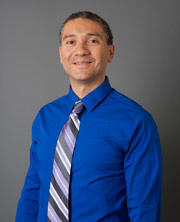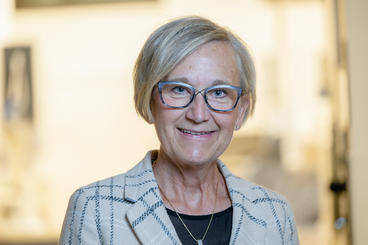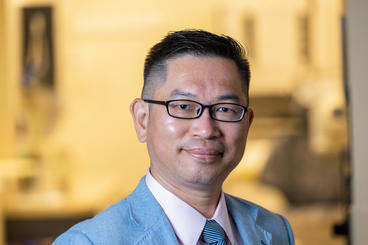Get to know the 2024 Veden Grant awardees

Five School of Dentistry faculty members received Veden awards through the Oral Health Clinical Research Center, director Eric Schiffman, DDS, MS, announced in March.
Funding for these proposals is provided, in part, by the Frank W Veden Endowment for Clinical Research fund. Established in 1990, funds were granted through Veden’s estate in 1997. A dentist and 1936 graduate from the School of Dentistry, Veden established the fund, to which others have continued to contribute, out of his desire to encourage clinical research and its ability to transfer basic science knowledge into practical applications.
Get to know the winners of the 2024 awards.
Estephan Moana Filho, DDS, MS, PhD

The Role of Endogenous Pain Inhibition Deficiency in Chronic TMD Pain Pathophysiology
Why did you decide to pursue the grant?
I see the offering of the OHCRC Frank W. Veden Grant as a great opportunity to obtain funding for small/pilot research projects like ours, which will generate preliminary data for larger research projects proposals to be submitted as extramural grant proposals to external agencies such as the NIH.
Provide us with a brief overview of your project.
We know that most individuals have the intrinsic ability to up or downregulate pain perception, as a result of varied brain-based processes - for example, think about a sports player who suffers an injury but only feels the pain once they are done performing. One way to test this intrinsic pain inhibition ability in humans is through conditioned pain modulation (CPM) testing, and previous studies using CPM to test pain inhibition in chronic jaw pain patients reported mixed results where some reported deficient pain inhibition in patients relative to pain free controls while other studies did not.
Our project, "The Role of Endogenous Pain Inhibition Deficiency in Chronic TMD Pain Pathophysiology," will investigate distinct features of pain inhibition and its potential deficiency in the expression of chronic jaw pain related to temporomandibular disorders (TMDs). We expect that the results will provide us a better understanding of: 1. Potential regional deficiencies of pain inhibition over the face, thus leading to increased jaw pain perception in affected individuals; 2. The relationship between pain inhibition efficiency and variability of clinical TMD pain intensity, so that individuals with less efficient pain inhibition are expected to experience greater pain intensity variability over time.
How will the grant funds impact your research?
The OHCRC Frank W. Veden Grant is a great funding mechanism to support a pilot study like ours. Our research team is grateful to be awarded and we will work hard to complete this study and do the data analysis, in order to determine if the results match our expectations. Based on these results, we will plan the next steps in this research line and develop future research projects to further our understanding of chronic jaw pain mechanisms.
Cyndee Stull, DHSc, MDH, RH

Examining the feasibility of enhanced oropharyngeal exams
Why did you decide to pursue the grant?
Yvette Reibel, EdD, LDH, and I have developed a training program to teach students how to perform a tactile examination of the tonsils and base of tongue for secondary prevention/screening of oropharyngeal cancer. We have been working with the Bakken Biomedical Device Center to develop a VR environment and a manikin simulating tonsillar, base of tongue, and soft palate tumors as a first phase of the training before performing the examination on live patients.
Provide us with a brief overview of your project.
The rationale for this study is that dental providers don't typically use a tactile examination of the oropharynx because it can cause discomfort/gagging for the patient and dental providers are not trained in the technique. The study will look at the effectiveness of using simulation to teach the specific technique that is used by otolaryngologists to improve student comfort and confidence prior to performing on patients. We will also explore the perceptions of patients receiving the screening.
How will the grant funds impact your research?
The grant will allow us to complete the first phase of the training and move into the second phase of the training which will take place in the OHCRC. We will be able to explore the feasibility of a routine tactile exam of the oropharyngeal area, which is not commonly done in practice. We hope the findings will inform a larger study in the future.
Boyen Huang, DDS, MHA, PhD, ADC Cert.

Development of Machine Learning Model for Mobile Health Assessment of Traumatic Dental Injuries and Support of Clinical Decision Making.
Why did you decide to pursue the grant?
Because this grant can be a good support to develop a technology for clinical dentistry.
Provide us with a brief overview of your project.
This team project plans to develop a model for mobile health (mHealth) practice that utilizes artificial intelligence (AI) to assess dental photos and detect traumatic dental injuries and other tooth structure loss from these images. When our AI model achieves adequate diagnostic performance from images, we will integrate patient-perceived oral health status into the clinical decision-making process of the mHealth practice.
How will the grant funds impact your research?
The funding allows us to start data collection at the Minnesota State Fair D2D Research Facilities. It will also be used to support the SOD Information Technology (IT) Team that will help us create a photographic assessment platform relevant to this project. Further, receiving the award encourages my team to explore and apply for other grant opportunities to support this multicenter research.
Rachel Uppgaard, DDS

MRI for the Early Detection of Pathology in the Fanconi Anemia Patient
Why did you decide to pursue the grant?
As an investigator who is early in the profession, I'm looking to get funding, and this grant was easy to get information about and apply to. Being able to work with the OHCRC group was straightforward and I was able to get my questions answered.
Provide us with a brief overview of your project.
I work with a small group of patients with Fanconi Anemia, a rare autosomal disorder that often leads to bone marrow failure and has a very high risk of head and neck cancer. They need to limit their exposure to radiation due to the risk of DNA damage, so there is not a good adjunct to clinical examination with imaging. MRI is an imaging modality that has the potential to give us more information and hopefully detect some of these premalignancies or malignancies earlier. My patients will receive MRIs in addition to their clinical examinations.
How will the grant funds impact your research?
I am very grateful for these grant funds so that I can get this project up and running. It's expensive to get MRIs and have them read by a trained radiologist.
Mike John, PhD, DMD, MPH

Why did you decide to pursue the grant?
To pursue our medical-dental integration research efforts, our team needed pilot data to explore the relationship between oral health-related and (general) health-related quality of life. OHCRC’s rapid review and swift decision-making were the crucial factors why we sought funding from the SOD to move our medical-dental integration research efforts forward.
Provide us with a brief overview of your project.
In a representative sample of the adult general population in Minnesota, we will determine the relationship between oral health-related quality of life and health-related quality of life to characterize the link between oral health and general health.
How will the grant funds impact your research?
The statement of the former Surgeon General C. Everett Koop, “You're not healthy without good oral health.” points to medical-dental integration as one of dentistry’s most important research areas. The grant project will pave the way to integrate the OHIP-5, an instrument to measure oral health impact, in one of the nation’s major health surveys, the Behavioral and Risk Factor Surveillance System, to characterize the oral health – general health relationship.